Abstract
Neuroendocrine gut and pancreatic tumors are known to contain and secret different peptide hormones and amines. During the last two decades, many radioimmunoassays and Elizas have been developed to analyze these substances in blood and urine, which has enabled clinicians to improve the diagnosis and monitoring of patients with various neuroendocrine tumors. Due to cost constraints in medical care, it is important to try to define the most useful biochemical markers from the clinical point of view. The glycoprotein chromogranin A has been shown to be a useful marker for diagnosing various neuroendocrine tumors, both by histopathology and circulating tumor markers. In patients with demonstrable endocrine tumors, about 90 percent of the patients present high circulating levels of chromogranin A. A hundred-fold increase of plasma chromogranin is seen in patients with midgut carcinoid tumors and liver metastases. The plasma levels of chromogranin A reflect the tumor mass and can be used for monitoring the patient during treatment and follow-up, although the day-to-day variation might be 30-40 percent. High circulating levels of the chromogranin A might be an indicator of bad prognosis in patients with malignant carcinoid tumors. Besides analyzing plasma chromogranin A, specific analyses such as urinary 5-HIAA in midgut carcinoid patients, serum gastrin in patients with Zollinger-Ellison syndrome and insulin/proinsulin in patients with hypoglycemia should be performed. In patients with small tumor masses or intermittent symptoms, provocative tests such as a meal stimulation test, secretin test or pentagastrin stimulation of tachykinin release can supplement the basal measurements of peptides and amines. To fully evaluate the growth potential in neuroendocrine tumors, traditional biochemical markers should be supplemented with indicators of growth proliferation (Ki-67, PCNA) and immunohistochemical staining for the adhesion molecule CD44 and the PDGF-alpha receptor. Finally, analysis of somatostatin receptor subtypes and induction of the enzymes 2-5A syntethase and PKR are of clinical value.
Full text
PDF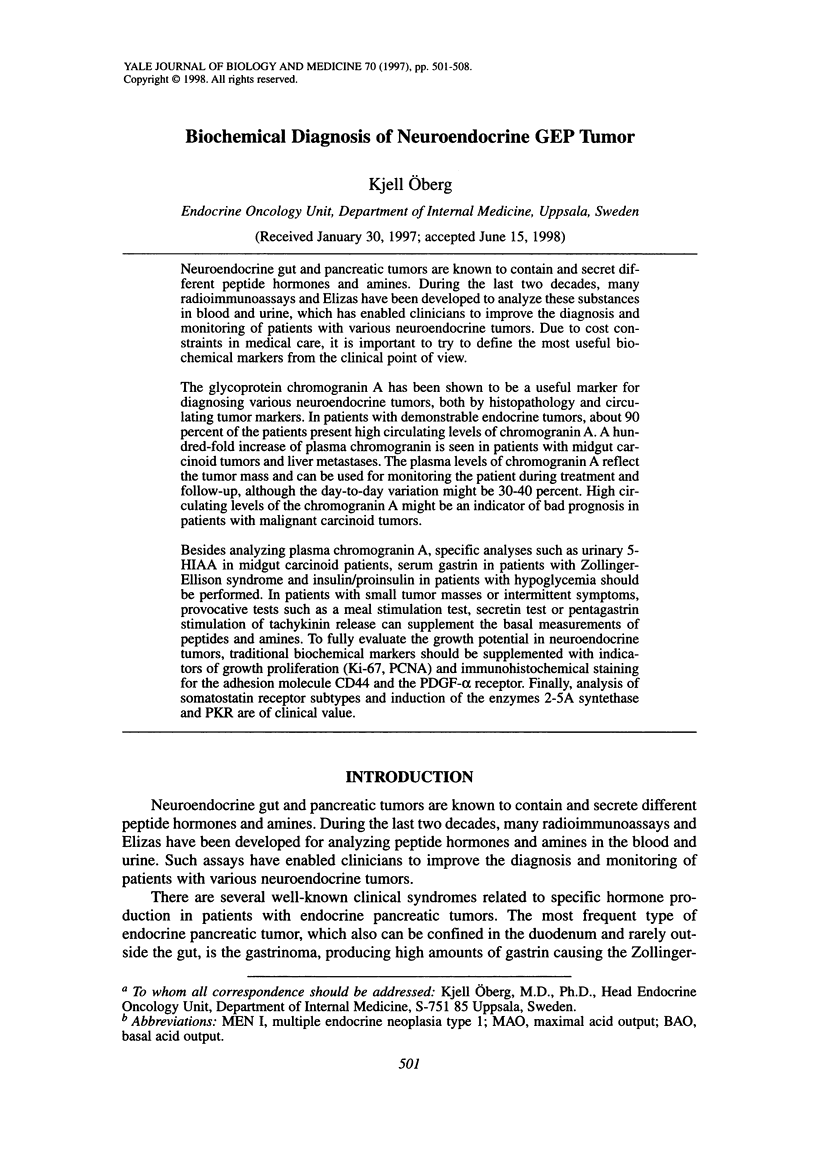
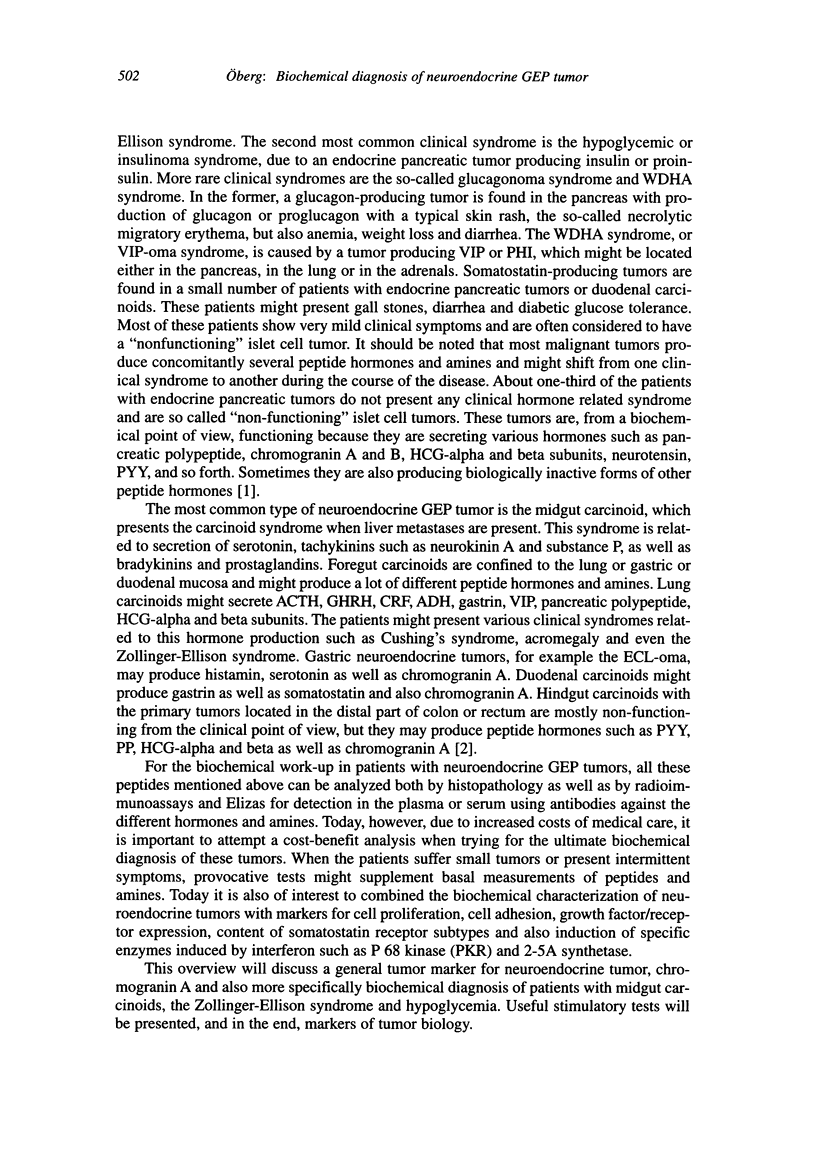
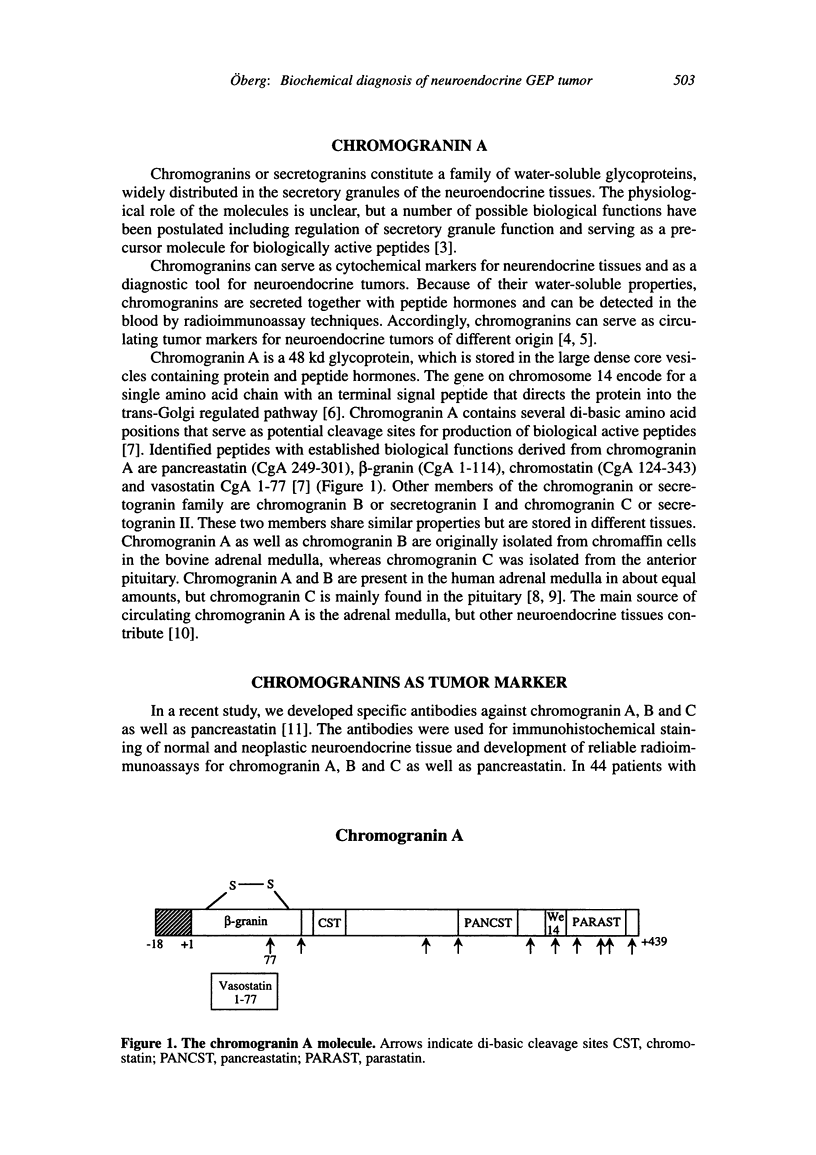
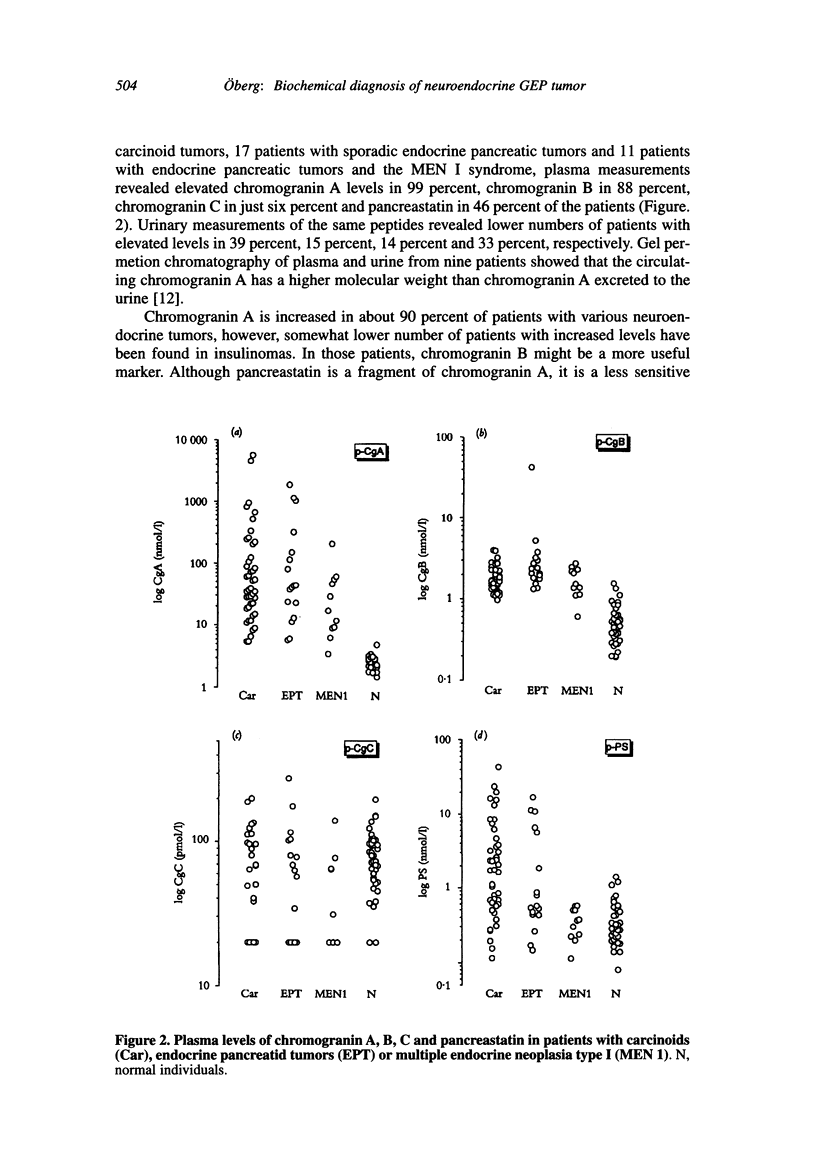
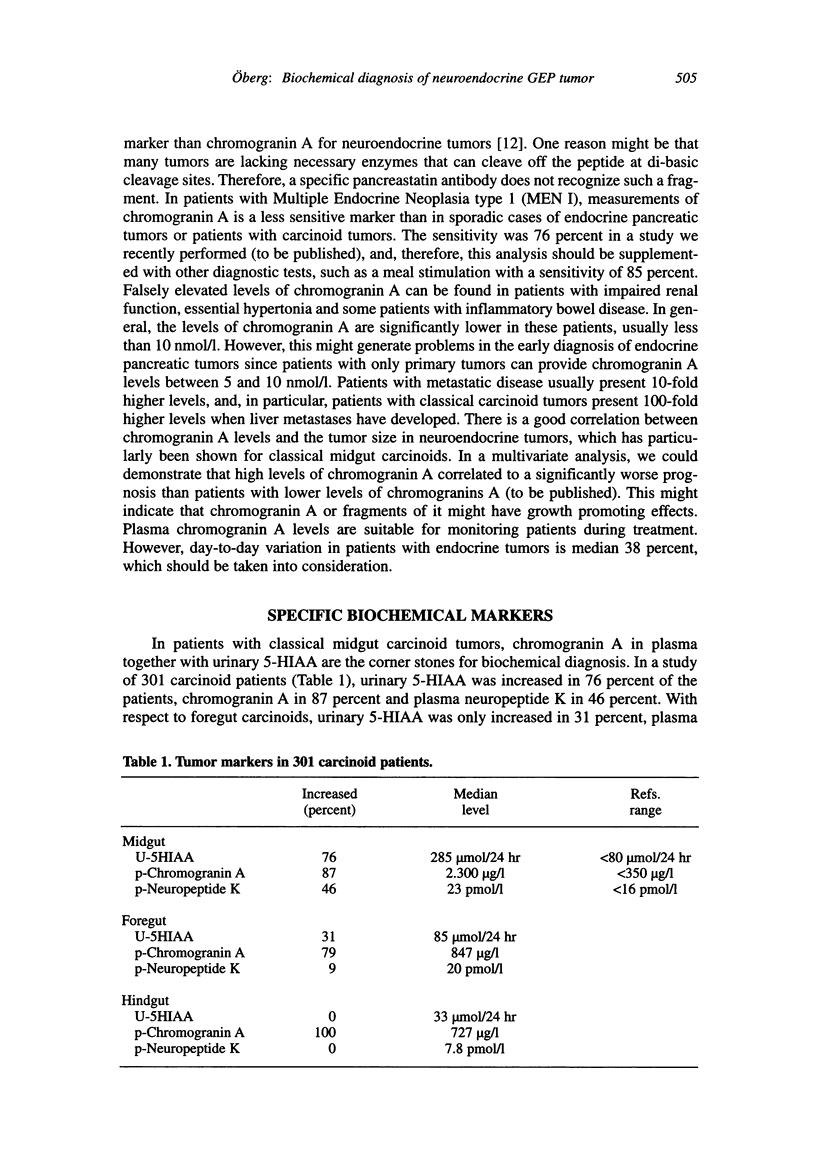
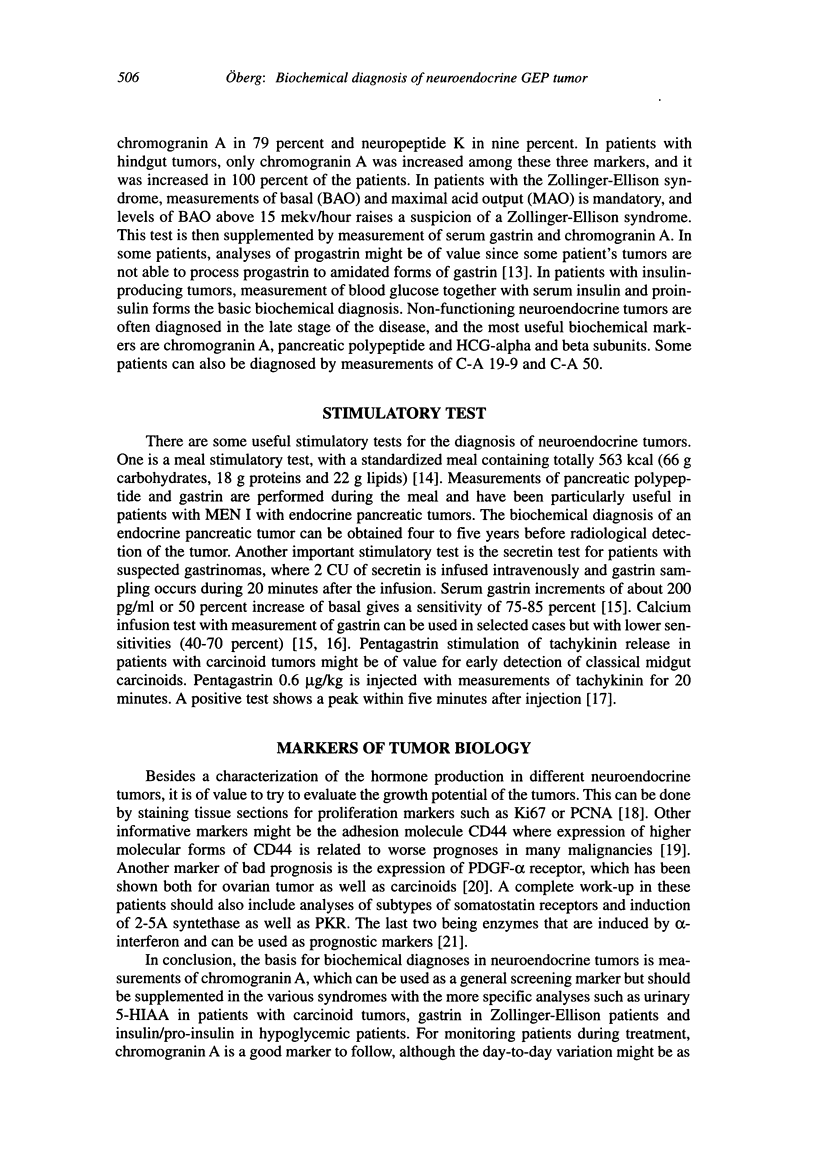
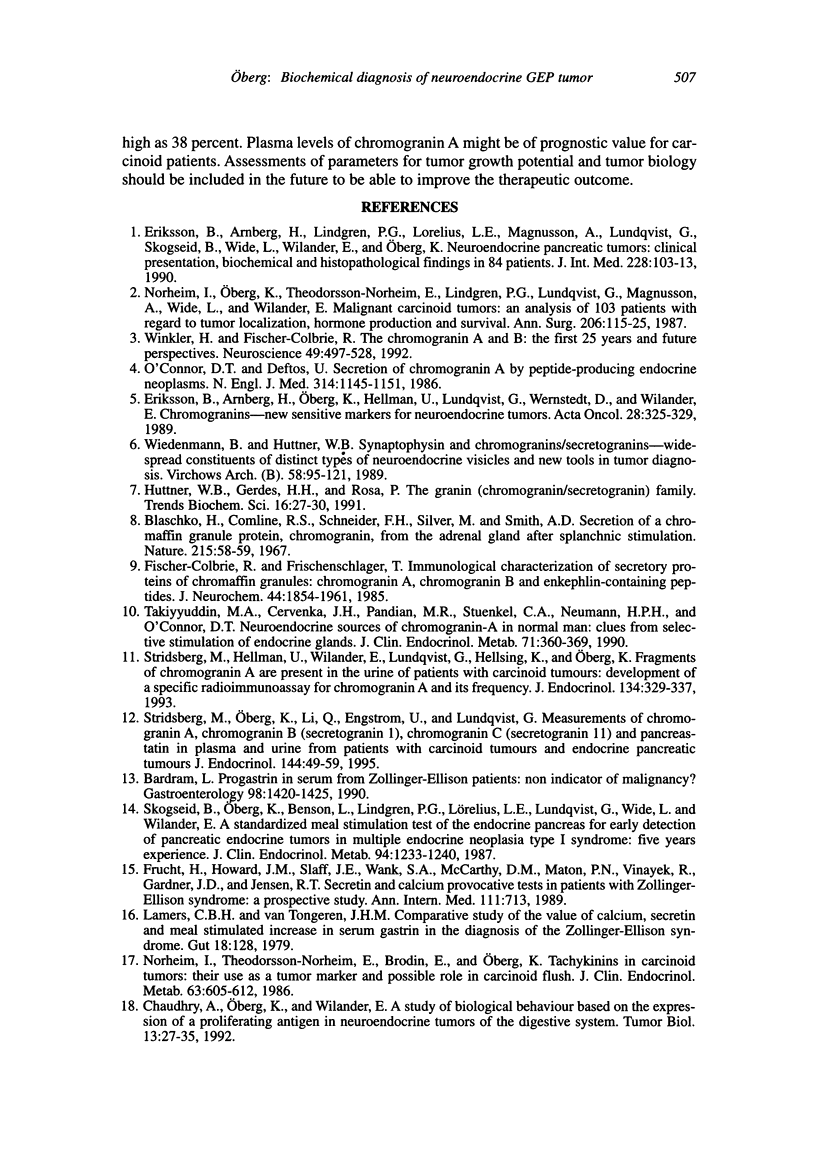

Selected References
These references are in PubMed. This may not be the complete list of references from this article.
- Bardram L. Progastrin in serum from Zollinger-Ellison patients. An indicator of malignancy? Gastroenterology. 1990 Jun;98(6):1420–1426. doi: 10.1016/0016-5085(90)91071-d. [DOI] [PubMed] [Google Scholar]
- Blaschko H., Comline R. S., Schneider F. H., Silver M., Smith A. D. Secretion of a chromaffin granule protein, chromogranin, from the adrenal gland after splanchnic stimulation. Nature. 1967 Jul 1;215(5096):58–59. doi: 10.1038/215058a0. [DOI] [PubMed] [Google Scholar]
- Chaudhry A., Gobl A., Eriksson B., Skogseid B., Oberg K. Different splice variants of CD44 are expressed in gastrinomas but not in other subtypes of endocrine pancreatic tumors. Cancer Res. 1994 Feb 15;54(4):981–986. [PubMed] [Google Scholar]
- Chaudhry A., Oberg K., Wilander E. A study of biological behavior based on the expression of a proliferating antigen in neuroendocrine tumors of the digestive system. Tumour Biol. 1992;13(1-2):27–35. doi: 10.1159/000217749. [DOI] [PubMed] [Google Scholar]
- Eriksson B., Arnberg H., Lindgren P. G., Lörelius L. E., Magnusson A., Lundqvist G., Skogseid B., Wide L., Wilander E., Oberg K. Neuroendocrine pancreatic tumours: clinical presentation, biochemical and histopathological findings in 84 patients. J Intern Med. 1990 Aug;228(2):103–113. doi: 10.1111/j.1365-2796.1990.tb00202.x. [DOI] [PubMed] [Google Scholar]
- Eriksson B., Arnberg H., Oberg K., Hellman U., Lundqvist G., Wernstedt C., Wilander E. Chromogranins--new sensitive markers for neuroendocrine tumors. Acta Oncol. 1989;28(3):325–329. doi: 10.3109/02841868909111201. [DOI] [PubMed] [Google Scholar]
- Fischer-Colbrie R., Frischenschlager I. Immunological characterization of secretory proteins of chromaffin granules: chromogranins A, chromogranins B, and enkephalin-containing peptides. J Neurochem. 1985 Jun;44(6):1854–1861. doi: 10.1111/j.1471-4159.1985.tb07179.x. [DOI] [PubMed] [Google Scholar]
- Frucht H., Howard J. M., Slaff J. I., Wank S. A., McCarthy D. M., Maton P. N., Vinayek R., Gardner J. D., Jensen R. T. Secretin and calcium provocative tests in the Zollinger-Ellison syndrome. A prospective study. Ann Intern Med. 1989 Nov 1;111(9):713–722. doi: 10.7326/0003-4819-111-9-713. [DOI] [PubMed] [Google Scholar]
- Grandér D., Oberg K., Lundqvist M. L., Janson E. T., Eriksson B., Einhorn S. Interferon-induced enhancement of 2',5'-oligoadenylate synthetase in mid-gut carcinoid tumours. Lancet. 1990 Aug 11;336(8711):337–340. doi: 10.1016/0140-6736(90)91879-f. [DOI] [PubMed] [Google Scholar]
- Henriksen R., Funa K., Wilander E., Bäckström T., Ridderheim M., Oberg K. Expression and prognostic significance of platelet-derived growth factor and its receptors in epithelial ovarian neoplasms. Cancer Res. 1993 Oct 1;53(19):4550–4554. [PubMed] [Google Scholar]
- Huttner W. B., Gerdes H. H., Rosa P. The granin (chromogranin/secretogranin) family. Trends Biochem Sci. 1991 Jan;16(1):27–30. doi: 10.1016/0968-0004(91)90012-k. [DOI] [PubMed] [Google Scholar]
- Lamers C. G., Van Tongeren J. H. Comparative study of the value of the calcium, secretin, and meal stimulated increase in serum gastrin to the diagnosis of the Zollinger-Ellison syndrome. Gut. 1977 Feb;18(2):128–135. doi: 10.1136/gut.18.2.128. [DOI] [PMC free article] [PubMed] [Google Scholar]
- Norheim I., Oberg K., Theodorsson-Norheim E., Lindgren P. G., Lundqvist G., Magnusson A., Wide L., Wilander E. Malignant carcinoid tumors. An analysis of 103 patients with regard to tumor localization, hormone production, and survival. Ann Surg. 1987 Aug;206(2):115–125. doi: 10.1097/00000658-198708000-00001. [DOI] [PMC free article] [PubMed] [Google Scholar]
- Norheim I., Theodorsson-Norheim E., Brodin E., Oberg K. Tachykinins in carcinoid tumors: their use as a tumor marker and possible role in the carcinoid flush. J Clin Endocrinol Metab. 1986 Sep;63(3):605–612. doi: 10.1210/jcem-63-3-605. [DOI] [PubMed] [Google Scholar]
- O'Connor D. T., Deftos L. J. Secretion of chromogranin A by peptide-producing endocrine neoplasms. N Engl J Med. 1986 May 1;314(18):1145–1151. doi: 10.1056/NEJM198605013141803. [DOI] [PubMed] [Google Scholar]
- Skogseid B., Oberg K., Benson L., Lindgren P. G., Lörelius L. E., Lundquist G., Wide L., Wilander E. A standardized meal stimulation test of the endocrine pancreas for early detection of pancreatic endocrine tumors in multiple endocrine neoplasia type 1 syndrome: five years experience. J Clin Endocrinol Metab. 1987 Jun;64(6):1233–1240. doi: 10.1210/jcem-64-6-1233. [DOI] [PubMed] [Google Scholar]
- Stridsberg M., Hellman U., Wilander E., Lundqvist G., Hellsing K., Oberg K. Fragments of chromogranin A are present in the urine of patients with carcinoid tumours: development of a specific radioimmunoassay for chromogranin A and its fragments. J Endocrinol. 1993 Nov;139(2):329–337. doi: 10.1677/joe.0.1390329. [DOI] [PubMed] [Google Scholar]
- Stridsberg M., Oberg K., Li Q., Engström U., Lundqvist G. Measurements of chromogranin A, chromogranin B (secretogranin I), chromogranin C (secretogranin II) and pancreastatin in plasma and urine from patients with carcinoid tumours and endocrine pancreatic tumours. J Endocrinol. 1995 Jan;144(1):49–59. doi: 10.1677/joe.0.1440049. [DOI] [PubMed] [Google Scholar]
- Takiyyuddin M. A., Cervenka J. H., Pandian M. R., Stuenkel C. A., Neumann H. P., O'Connor D. T. Neuroendocrine sources of chromogranin-A in normal man: clues from selective stimulation of endocrine glands. J Clin Endocrinol Metab. 1990 Aug;71(2):360–369. doi: 10.1210/jcem-71-2-360. [DOI] [PubMed] [Google Scholar]
- Wiedenmann B., Huttner W. B. Synaptophysin and chromogranins/secretogranins--widespread constituents of distinct types of neuroendocrine vesicles and new tools in tumor diagnosis. Virchows Arch B Cell Pathol Incl Mol Pathol. 1989;58(2):95–121. doi: 10.1007/BF02890062. [DOI] [PubMed] [Google Scholar]
- Winkler H., Fischer-Colbrie R. The chromogranins A and B: the first 25 years and future perspectives. Neuroscience. 1992 Aug;49(3):497–528. doi: 10.1016/0306-4522(92)90222-N. [DOI] [PMC free article] [PubMed] [Google Scholar]


